Science Highlights, October 29, 2015
Awards and Recognition
Experimental Capability Enhancement
MXRF provides improved elemental analysis capabilities
Materials Science and Technology
Enriched uranium pellets fabricated for test irradiations of accident-tolerant nuclear fuels
Awards and Recognition
Michele DeCroix receives award from Department of Homeland Security

Michele DeCroix
The Department of Homeland Security recognized Michele DeCroix (Nuclear Engineering and Nonproliferation, NEN-DO) with a Secretary’s Award for Excellence at a special ceremony in Washington, DC. The team award included members from U.S. Customs and Border Protection (CBP) and the Domestic Nuclear Detection Office (DNDO). The Department of Homeland Security specifically honored DeCroix for her work on nuclear terrorism risk assessments during an Interagency Personnel Assignment at DNDO, where she served as Risk Branch Chief and a Senior Technical Advisor. The Lab’s Systems Design and Analysis (NEN-5) group supported the project with nuclear threat modeling conducted for DNDO. The NEN-5 threat model, combined with a subject matter elicitation from weapons designers at LANL and Lawrence Livermore National Laboratory, enabled characterization of the likelihood that a terrorist would use certain nuclear materials or attempt to build and deploy certain nuclear weapon design classes. The likelihood information, plus additional adversary preferences that are elicited from the Intelligence Community, were used to calculate a factor for each device that represents how important it is to detect that device. This importance factor defined a “trade space” to evaluate the impact of potential U.S. Customs and Border Protection radiation portal detection setting changes and understanding if overall detection capabilities were degraded or improved. The Customs and Border Protection project changed its radiation portal monitor settings based on this information. The analysis helped to reduce the number of false alarms and contributed to the realization of $67 million in savings for monitors, maintenance, and personnel, while securing the homeland against radiological and nuclear threats.
DeCroix graduated from North Carolina State University with a doctorate in mechanical engineering and joined the Laboratory in 1998. She has 25 years of engineering science experience, including nuclear weapon subsystem design and assessment of engineering processes in weapons of mass destruction. Approximately half her work has involved the design and operation of experiments. The remaining work has focused on computational and analytical model development including system models for a variety of U.S. government sponsors. Her other awards include: American Society for Quality: Frank Wilcoxon Prize for Best Practical Application Paper, NNSA Defense Programs Award of Excellence, and a NASA Technology Utilization Award for Computational Engineering System for Rapid Computational Fluid Design Analysis. Technical contact: Michele DeCroix
Harp, Holesinger, and Myers honored for NMBSA “Success Stories”
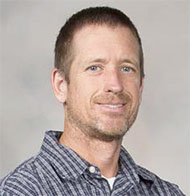
Dylan Harp
The New Mexico Small Business Assistance (NMBSA) Program honored the work of Laboratory researchers Dylan Harp, Terry Holesinger, and Kary Myers as “Success Stories”. Each of their projects provided technical support for Santa Fe businesses.
Dylan Harp (Computational Earth Science, EES-16) was the principal investigator of a leveraged project that assisted businesses in becoming more competitive in the global geothermal community via the use of software tools for geothermal energy site selection. Geothermal energy is an attractive energy source. However, capital costs can be significant and risks associated with site selection need to be minimized. Availability of sophisticated modeling tools to evaluate geothermal resources is limited. William Glassley (Earth System Sciences, LLC) and his partners at Geo-Risk, LLC and TERRAMAR, Inc. formulated the idea of a software tool using statistical methods to conduct resource evaluation and risk analysis, but these small businesses did not have the technical expertise to make this software a reality. Harp’s expertise with software tools used in decision support for remediation and monitoring of contaminated groundwater enabled him to adapt existing analysis and visualization tools for geothermal exploration applications. Harp developed: 1) a geothermal simulation sampling scheme to identify and weight plausible natural states, and 2) risk analysis metrics based on production simulations and automatic visualization of results using Paraview. He demonstrated the use of the tool on an example geothermal investigation.
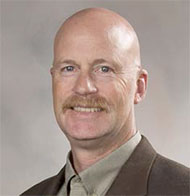
Terry Holesinger
Terry Holesinger (Materials Synthesis and Integrated Devices, MPA-11) was the principal investigator for research with iBeam Materials. Light-emitting diodes (LEDs) are limited by substrates that are small, rigid, and complex. The iBeam technology, developed with contributions from Los Alamos and Sandia National Laboratories, enables the creation of LEDs directly on flexible, large-area, and low-cost metal foils.
Holesinger performed SEM (scanning electron microscopy) and STEM (scanning transmission electron microscopy) characterization of iBeam’s gallium nitride samples for LEDs. This information assisted iBeam with process optimization of their highly engineered samples. The company intends to target the horticulture lighting industry first and then expand into other lighting and display markets.
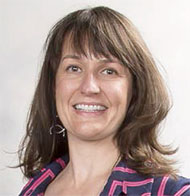
Kary Myers
Kary Myers (Statistical Sciences, CCS-6) was the principal investigator of a leveraged project with Pharma Connect Xpress. Research estimates show that as many as 60% of medical practices restrict access to pharmaceutical representatives, yet physicians continue to need informative resources. The Pharma Connect Xpress platform offers a user-centered solution that transforms pharmaceutical promotion and benefits physicians, pharmaceutical companies, and patients.
Myers applied her statistics and machine-learning expertise to explore data from Xpress’s pilot studies. She suggested analysis strategies to obtain as much information as possible from the Xpress data and helped craft a data-analytics explanation of the value of the Xpress system to stakeholders. Her involvement gave Xpress the analytical sophistication needed to meet its goals. Xpress uses the results to articulate the applicability and usefulness of the software to investors and potential partners from pharmaceutical companies and healthcare institutions.
In 2000, the New Mexico State Legislature created the Laboratory Partnership with Small Business Tax Credit Act for the purpose of “bringing the technology and expertise of the national laboratories to small businesses in New Mexico to promote economic development in the state, with an emphasis on rural areas.” During 2014, NMSBA helped 352 small businesses across the state reach business goals, develop their products for commercial use, and increase profitability. More information: http://www.nmsbaprogram.org/ Technical contact: Becky Coel-Roback
Bioscience
Climate change impact on arid biological crust communities
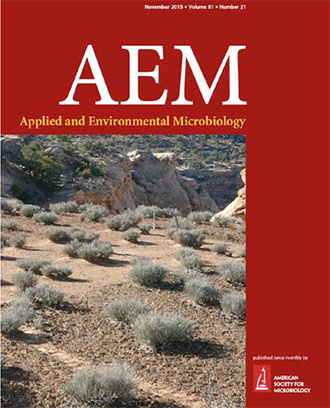
Figure 1. Cover photograph (Copyright © 2015, American Society for Microbiology. All Rights Reserved): Biocrusts dominated by cyanobacteria cover much of the soil surface in natural arid landscapes and contribute to photosynthesis, N2 fixation, soil nutrition and stability, and plant health. Physical disturbances easily damage biocrusts. The image shows pigmented biocrusts (lower right) on the Colorado Plateau (UT) and physically disturbed biocrusts in an adjacent area (upper left). Multiyear exposure of biocrusts to slight changes in the summer precipitation pattern, 2°C soil warming, and a combined treatment caused biocrust damage that visibly mimicked damage seen in physically disturbed soils. The biomass and composition of the biocrust bacterial community changed in very different ways.
The cover of the November issue of Applied and Environmental Microbiology (AEM) features a new study by a research team led by Laboratory Fellow Cheryl Kuske (Bioenergy and Biome Sciences, B-11). The research compares the ways arid grasslands respond to climate changes and human activities that cause physical disturbance. Alterations in land use, coupled with regional climate changes, may push dryland ecosystems into new ecological states of unknown composition and function. The team conducted multiple long-term field experiments in Utah. Two related papers in Frontiers in Microbiology reported the Kuske team’s work from field experiments in Nevada to examine the effects of additional nitrogen on bacterial and fungal communities in surface soils. Atmospheric deposition of nitrogen could increase as human use of the land for living spaces, recreation, and energy development expands.
In arid lands where plants are widely spaced, microbes colonize the soil between the plants and form biological crusts (biocrusts) that are held closely together to form a physical crust. Biocrust organisms are responsible for important ecosystem services such as carbon and nitrogen fixation, soil stabilization, and water retention. The team used metagenomic techniques to analyze the mass and composition of microorganisms through analysis of their collective genomic material. The researchers compared the responses of different biocrust microbes, such as bacteria and fungi, with multiple combinations of disturbance. These disturbances included foot trampling, warming, changes in precipitation pattern, and atmospheric nitrogen amendment (e.g. from power plant emissions).
The Applied and Environmental Microbiology paper reported on test sites that had, over multiple years, exposed biocrusts to slight changes in the summer precipitation pattern, 2°C soil warming, and a combined treatment. The results showed that both climate and land use (trampling) changes affected soil community structure and functions. Different types of disturbance damage biocrusts in macroscopically similar ways to cause barren and empty soils. However, the disturbances differentially impact the composition of resident soil bacterial communities and consequent functional profile. Combined warming plus precipitation caused the resident population of organisms to change completely and lose the ability to input carbon and nitrogen into the soil. The work shows that visual assessments of ecosystem health do not accurately assess or predict climate change impact in arid lands because what is happening to the microbes in the soil occurs on a smaller scale that is much more complicated. This result has important implications for the management and restoration strategies of dryland ecosystems. The mechanism of disturbance must be considered when assessing the health and functioning of biocrust communities. The finding that each of the manipulations affects unique combinations of bacterial genera offers the possibility of tracking particular bacterial taxa to monitor the status of biocrust communities. This may be the first step for developing molecular diagnostic tools to apprise land managers of the health of local biocrust communities and identifying the mechanisms and consequences of various disturbances.
The papers published in Frontiers in Microbiology feature related work from field experiments in Nevada. The team used genomic analysis to examine the effects of additional nitrogen on surface soils across varied depths and microhabitats. Both studies combined measures of enzyme function and metagenomic sequencing to study the big picture of flux and growth in microbes. Widely spaced plants and interspace biocrusts provide soil nutrients in a localized fashion to create a mosaic pattern of plant- or crust-associated microhabitats with distinct nutrient composition. The scientists observed greater nutrient availability, microbial biomass, and process rates in soils beneath the shrub canopy compared with the interspace between plants, and greater in the surface biocrust horizon compared with the deeper 10 cm soil profile. Modest increases on nitrogen content had a positive (growth) affect on the soil health, but too much was toxic. Analysis of the differences among microbes revealed that nitrogen changes the composition of bacteria more than that of fungi. Increased nitrogen input in many arid ecosystems could shift nutrient cycling towards pathways driven primarily by fungal communities. Fungi and bacteria have different functional roles and patterns of resource utilization related to decomposition. Therefore, shifts in the relative abundance of these two groups could alter biogeochemical cycles.
Drylands (arid and semiarid lands) comprise about 35% of the terrestrial surface of the western US and 41% of global terrestrial lands. Over 35% of the world’s human population depends on dryland ecosystems for their livelihood, and this number is increasing. These resource-limited ecosystems have low resilience and resistance to abiotic perturbations. Understanding soil microbial community responses will provide insight regarding how the functions of dryland soils may change in response to future conditions, and how drylands can be managed to maintain productivity and resilience of microbial communities.
References:
“Soil Microbial Responses to Nitrogen Addition in Arid Ecosystems,” Frontiers in Microbiology 6, 819 (2015); doi: 0.3389/fmicb.2015.00819. Authors: Robert Sinsabaugh, Jennifer Rudgers, and Noelle Martinez (University of New Mexico); Jayne Belnap (U.S. Geological Survey); Cheryl Kuske (B-11); and Darren Sandquist (v).
“Soil Microbial and Fungal Community Responses to Nitrogen Addition Across Soil Depth and Microhabitat in an Arid Shrubland,” Frontiers in Microbiology 6, 891 (2015); doi: 10.3389/fmicb.2015.00891. Authors: Rebecca Mueller and Cheryl Kuske (B-11), and Jayne Belnap (U.S. Geological Survey).
The DOE Office of Science, Biological and Environmental Research funded the LANL research, and Laboratory Research and Development (LDRD) sponsored a Director’s Postdoctoral Fellowship and DNA sequencing. The work supports the Lab’s Energy Security and Global Security mission areas and the Science of Signatures science pillar through understanding the impact of climate change on soil microbial communities and land productivity. Technical contact: Cheryl Kuske
Earth and Environmental Sciences
Tree mortality and forest die-off from droughts
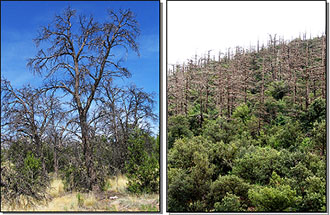
Photos. Examples of mortality of taller trees and survival of shorter trees. Note that the surviving trees and shrubs that now occupy these sites store much less carbon than the forests they have replaced. (Left): Pinus edulis mortality, with surviving understory of Juniperus monosperma, in the Jemez Mountains, NM. (Right): Cedrus atlantica mortality, with surviving understory of Quercus ilex, Fraxinus xanthoxyloides, and Juniperus oxycedrus in Belezma National Park, Algeria. Images courtesy of C. D. Allen (left); C. Gazi and A. Briki (right).
A trio of papers by Nate McDowell (Earth System Observations, EES-14) and collaborators examined tree mortality during drought and climate warming. Tree mortality rates have risen substantially throughout much of North America in recent decades, and regional forest mortality events have increased globally. Forests store the majority of terrestrial carbon, and dying trees release carbon. Thus, forest loss may have significant and sustained impacts on the global carbon cycle and other climate feedbacks.
A paper published in Nature Climate Change uses a hydraulic corollary of Darcy’s law, a core principle of vascular plant technology, to predict the characteristics of plants that will either survive or die during drought under warmer future climates. Vascular plants obey Darcy’s law at the individual and stand levels. This allows estimates of physiological and structural responses of trees to climate change. Application of the law predicts a decline of canopy-scale water conductance due mostly to a greater vapor pressure deficit associated with warming surface temperatures. Plant-hydraulic modifications that take place to accommodate higher evaporative demand include reductions in height or leaf area and increases in hydraulic conductance and soil-to-leaf gradient.
As a result, shrubby, low-saturated plants are more likely to survive, whereas tall, old growth forests become significantly more vulnerable. Both empirical and quantitative model projections suggest that shorter shrubs and grasses will increasingly replace tall coniferous forests over much of western North America in upcoming decades. Darcy’s law also provides a simple, robust framework to inform forest management practices promoting the survival of forests. These range from prescriptions for sustainable stand densities to more resilient tree species and genetic compositions to promote future forest survival in a strongly warming world. The team’s applications of Darcy’s law imply that plant stress from projected climate changes will drive new global vegetation patterns.
A paper published in Nature Plants assesses the impact of droughts on tree growth and mortality over large areas. Site- and region-specific studies suggest that large trees are typically more susceptible to die-off during drought when compared with smaller trees. However, drought studies over larger scales have not been systematically reviewed and analyzed. The impact of drought on forest structure and function is dependent upon which trees are most adversely affected. Mortality of small trees may modify future forest progression, whereas mortality of large trees could cause disproportionate losses of carbon and ecosystem function.
The team performed a meta-analysis of data on tree growth and mortality from 40 drought events in 38 forests worldwide to determine if the site and regional size-dependent sensitivity to drought holds more widely (Figure 2). The authors analyzed the ratio of diameter growth rate under drought to non-drought conditions, the ratio of mortality rate under drought to non-drought conditions, and the percentage of drought-related mortality. They included both natural and experimental droughts from semi-arid woodlands to tropical rainforests in their studies.
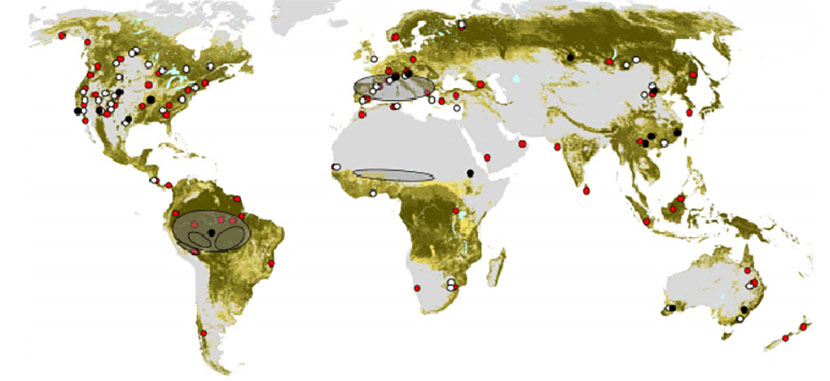
Figure 2. Worldwide drought events since 1970. Dot colors correspond to publications in which the drought events are compiled. Dark green depicts global forest cover, and light green represents other wooded regions.
The team found that drought consistently had a more detrimental impact on the growth of large trees in forests worldwide. The researchers attribute these findings to several factors. Large trees are more vulnerable, in part, due to their physiology: it is harder for them to transport the water and nutrients they need to their leaves, and evaporative demands (transpiration) are higher. Trees with crowns high in the canopy are exposed to higher solar radiation, and the ability to transport water to their foliage is lower. Trees close their stomata (surface pores that control gas exchange) during drought to prevent water loss from transpiration, but closure can collapse the hydraulic transport system. In contrast, the understory trees experience lower temperatures and wind speeds, higher humidity, and have a far shorter distance to transport water from their roots to their canopy. In all of the seasonal tropical forests analyzed by the team, the growth rate of understory trees increased in response to drought, possibly due to increased light reaching smaller trees as a result of foliage loss from larger trees under stress.
The observed size bias of growth and mortality rate responses to drought contrasts with what would be expected if larger trees had more reliable access to water during drought. Despite a greater root mass, larger trees do not necessarily have deeper roots or rely more heavily on deep water than smaller trees. Increases in transpiring leaf area balance increases in root mass with tree size. Thus, greater root mass does not give a substantive hydraulic advantage to large trees during drought.
Moreover, biotic agents commonly attack drought-stressed trees and may contribute to a size bias in drought-related decline. In cases where bark beetles are associated with drought related mortality (for example conifer die-offs in the western U.S.), the beetles preferentially attack larger trees.
As the climate warms and precipitation patterns change, leading to drier soils and more severe forest drought stress in many parts of the world, the team concludes that large trees are likely to suffer the most. The greater drought sensitivity of large trees has important implications for ecosystem-level carbon cycling responses to drought. Greater decreases in woody growth and associated carbon sequestration in long-lived woody tissues of large trees may occur. Large canopy trees can account for a greater proportion of ecosystem-level transpiration than smaller trees. Therefore, drought-related tree decline could reduce cooling of the land surface and transpiration contributions to cloud formation. Large trees have key ecological roles, creating unique above- and below-ground microenvironments on which many plant and animal species are dependent. Thus, die-off of large trees has significant implications for climate regulation and biodiversity in forests worldwide.
Ecosphere published a paper that examines the patterns, mechanisms, and consequences of tree mortality and forest die-off under hotter drought conditions. The authors compiled and studied key mortality-relevant findings to differentiate between the mechanisms causing lesser versus greater vulnerability and subsequent tree mortality. The team derived a set of six global vulnerability drivers that are known with high confidence: 1) droughts eventually occur everywhere, 2) warming results in hotter droughts, 3) atmospheric moisture demand increases nonlinearly with temperature during drought, 4) mortality can occur faster in hotter drought, 5) shorter droughts occur more frequently and can become lethal, and 6) mortality happens rapidly relative to growth intervals. The researchers conclude that most forests are much more vulnerable to tree mortality from hotter drought than commonly predicted. Therefore, the future vulnerability of forests globally is likely being widely underestimated. Recognizing and addressing these challenges is essential for a better understanding of tree mortality and die-off.
References:
“Larger Trees Suffer Most During Drought in Forests Worldwide,” Nature Plants 1, article number 15139 (2015); doi: 10.1038/nplants.2015.139. Authors: A. C. Bennett (Smithsonian Conservation Biology Institute and University of New Mexico), N. G. McDowell (EES-14), C. D. Allen (U.S. Geological Survey), and K. J. Anderson-Texeira (Smithsonian Tropical Research Institute and Smithsonian Conservation Biology Institute). The DOE Office of Science, Biological and Environmental Research including the Next Generation Ecosystem Experiments (NGEE) Tropics project, and the Laboratory Directed Research and Development (LDRD) program funded different aspects of the Los Alamos work.
“On Underestimation of Global Vulnerability to Tree Mortality and Forest Die-off from Hotter Drought in the Anthropocene,” Ecosphere 6 (8), 129 (2015); doi: 10.1890/ES15-00203.1. Authors: C. D. Allen (U.S. Geological Survey, D. D. Breshears (University of Arizona), and N. G. McDowell (EES-14). The DOE Office of Science, Biological and Environmental Research and the LDRD program funded different aspects of the Los Alamos work.
The research supports the Lab’s Energy Security and Global Security mission areas and the Science of Signatures and Information, Science and Technology science pillars through identification of the effects of climate change and feedbacks on trees. Technical contact: Nate McDowellExperimental Capability Enhancement
MXRF provides improved elemental analysis capabilities
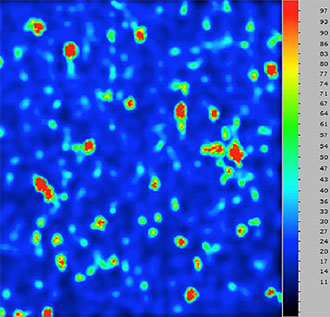
Figure 3. Zr elemental map of ZrO2 particles on collodion. Image covers approximately 1 x 1 mm with a 4-micrometer step size.
The Chemical Diagnostics and Engineering group (C-CDE) has brought online a powerful new capability to analyze samples for elemental composition. Sample types include metals, alloys, ceramics, polymers, thin films, particulates, glass, nanoparticles, solutions containing actinide materials, and more. Analyses of samples can be performed with little or no sample preparation.
The new micro x-ray fluorescence instrument, a Bruker M4 Tornado, provides rapid state-of-the-art nondestructive spatially resolved elemental analyses. The new instrument has two x-ray tubes, one rhodium and the other tungsten, which are equipped with different optics to spatially restrict the excitation beam on the surface of the specimen. The rhodium tube has a polycapillary optic that focuses the x-rays to create an intense x-ray photon flux of nominally 25 micrometer spot size on the sample. This intensity is 100 to 1000 times what could be obtained without a focusing optic. The tungsten tube has a 1 mm aperture. While this does not focus the X-rays, it provides analysis over a significantly larger area.
The real improvement over previous capability lies in the solid-state silicon drift detectors (SDD) used to detect emitted X-rays from the specimens. There are two detectors because there are two excitation sources. The big advantage of the SDDs is their ability to tolerate high count rates without saturation. These SDDs can easily handle 100 k counts per second without affecting the dead time of the detector response. Older detectors had a maximum count rate of only 20 k-25 k counts per second. This limitation severely restricted the maximum excitation energy and the photon flux on the sample, which limited the instrument’s sensitivity. The new M4 has outstanding sensitivity and rapid data collection that enable elemental maps to be collected in minutes. Older instruments required hours. Researchers have demonstrated the capabilities of the new instrument on some alloy castings and zirconium oxide (ZrO2) particles.
Figure 3 shows an ensemble of zirconium oxide particles. The Zr elemental map of the particles detected a range from 3-5 micrometers to over 30 micrometers. This map was collected within 20 minutes. A similar map on the older instrument took nearly 90 minutes. The advantages of rapid data collection, small spot size, and sub-parts-per-million (ppm) sensitivity provides new capabilities for materials characterization covering a wide range applications from the nanoscale to the macroscale, with sample sizes from tens of micrometers to over 150 mm on a side. Chemists can provide single point analysis, line scans, and elemental maps to determine spatially resolved elemental distributions from micrometers to centimeters.
Institutional equipment funds from the Principal Associate Directorate for Science, Technology and Engineering (PADSTE) purchased the instrument. The capability supports the Lab’s Nuclear Deterrence and Global Security mission areas and the Science of Signatures and Materials for the Future science pillar through elemental analyses of samples. Technical contact: George Havrilla
Thermal ionization mass spectrometry for actinides
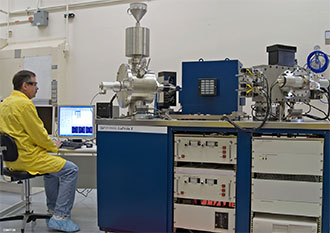
Photo. Russ Keller uses the Isoprobe-T for isotopic analysis.
The Actinide Analytical Chemistry Group (C-AAC) has significantly broadened its ability to support a variety of programs. Their new capabilities include measurements to identify trace isotopic signatures and reduce the uncertainty on hard-to-measure chronometers of americium (Am), plutonium (Pu), and uranium (U) (e.g. 241Am/241Pu, 234U/238Pu). If multiple chronometers disagree, the data can support quantitative models to determine what these differences mean. The chemists have developed more accurate measurement tools such as re-establishment of a high precision 243Am spike for isotope dilution mass spectrometry, created isotopes standards where none previously existed, and established high precision trace/minor isotope measurement techniques on their Isoprobe-T and Triton thermal ionization mass spectrometers.
For example, the team developed a more accurate and precise 241Puà241Am chronometer. This achievement involved both mass spectrometry and chemical development. Pu-241 has a very short half-life (14.33 years) among the Pu isotopes and rapidly produces measurable quantities of daughter 241Am. Thus, it is a viable chronometer in many materials. Am has different geochemical and processing behaviors compared to Pu’s other daughter isotopes (234U, 235U, and 236U), and it is more resistant to mobility in the environment. Therefore, excellent quantification of the 241Pu/241Am system is critical for determining the age of materials recovered from dissimilar environments and testing the meaning of model ages.
241Pu is a low abundance isotope in typical weapons plutonium. It is difficult to measure precisely and accurately, requiring complete separation from its isobaric daughter and excellent mass spectrometry. The well-established method of improving such a measurement, the Modified Total Evaporation technique, is problematic in the case of plutonium materials. This technique was developed to measure minor and trace uranium isotopes, requires very large samples (approximately 40 times more than traditionally used), and drastically increases run times. Pu is a greater radiological hazard than U. Thus, consistently loading large samples of plutonium is impractical from a safety standpoint, and the long run times prohibit high throughput.
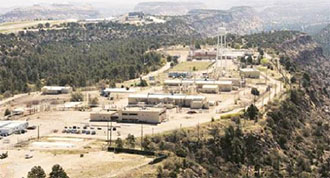
Photo. TA-21, the oldest plutonium facility in the U.S., as it once looked. Now, only a grassy field remains that can be directly interrogated for evidence of what it once accomplished. This site provides an excellent opportunity to test new analytical techniques.
To address this challenge, chemists developed a mixed-array, single-block variant of the traditional total evaporation technique on the Isoprobe-T. They team incorporated 1011 and 1012 Ohm feedback resistors within a single detection array. The variant improves measurements of Pu minor isotopes without increasing sample loading/run time requirements. The method enables an approximately threefold enhancement in sensitivity to minor and trace isotopes (e.g. 233U, 236U, 241Pu, 242Pu, and 244Pu) while reducing active measurement time and maintaining minimal sample loading requirements. When combined with the Isoprobe-T’s energy filtered ion counter to form a three part mixed detection array, this strategy greatly expands the ability to measure precise and accurate ages on a wide variety of challenging samples. The team also re-established the capability to manufacture a National Institute of Standards and Technology (NIST)-traceable 243Am spike, using 241Am and 243Am radiochemical standards. The spike improves Am isotopic assay values within Pu matrices.
The team used these materials in tandem with the improved techniques to re-analyze plutonium containing slurries collected from two late 1940’s era process storage tanks (i.e., the “General’s Tanks”, named for Gen. Leslie Groves, who installed them) located at the Lab’s Technical Area 21. The plutonium is an extremely low burnup material that was created during the early years of post-World War II plutonium production. It has a 240Pu concentration of approximately 1.5 atom percent. In spite of its current 241Pu concentration of only about 20 parts-per-million, the chemists dated the many decades old materials to an uncertainty of approximately 1 year. Comparison of the Pu-U and Pu-Am chronometry systems enabled the researchers to explain differences in determined model ages in terms of open-system behavior of U during loss of aqueous fluids during a historically documented event in the 1970s while Pu-Am remained coherent and closed on the microscale.
The actinide analytical capability supports the Lab’s Global Security mission area and the Science of Signatures science pillar. Technical contacts: Khal Spencer and Floyd Stanley
Mini-CAPTAIN snags first ionization track
Mini-CAPTAIN, the prototype for the Cryogenic Apparatus for Precision Tests of Argon Interactions with Neutrinos (CAPTAIN), demonstrated its first ionization track. The Mini-CAPTAIN detector is a liquid argon time projection chamber (TPC), a device capable of imaging charged particles via a trail of ionization electrons (ionization tracks) left behind when they interact with the argon nuclei. Its success makes it one of only a handful of liquid argon detectors now operating in the world. The neutrino worldwide research community increasingly uses liquid argon as a detection medium. This result paves the way for an international neutrino experiment.
The 1,000-channel liquid argon TPC with 400-kg instrumented mass is under commission at the Lab. The TPC relies on the Los Alamos Neutron Science Center’s (LANSCE) high-energy neutron beam, which is uniquely suited to aid understanding of how to reconstruct few-GeV neutrino interactions. Researchers will use the neutron data to measure cross-sections of spallation products that are backgrounds to measurements of neutrinos from a supernova burst and cross-sections of events that mimic the electron neutrino appearance signal in long-baseline neutrino physics. The data will enable development of strategies to count neutrons and evaluate their energies in a liquid argon TPC. This information is important for the total neutrino energy measurement in the analysis of long-baseline neutrinos. The data will enable larger and more complex neutrino experiments aimed at solving scientific grand challenges such as explaining the universe’s matter-antimatter asymmetry.
The CAPTAIN detector, a 5-ton instrumented mass liquid argon TPC with 2,000 channels, is also under construction at Los Alamos and will eventually run at the Fermi National Accelerator Laboratory. The CAPTAIN program addresses important scientific questions associated with the long-baseline, atmospheric, and supernova neutrino science of DUNE (Deep Underground Neutrino Experiment). DUNE is an international long-baseline neutrino program designed to aid neutrino science and proton decay studies. The Lab develops and manages the DUNE detector systems.
Los Alamos researchers working on Mini-CAPTAIN and the liquid argon TPC include Christopher Mauger, Elena Guardincerri, Gerald Garvey, David Lee, Qiuguang Liu, William Louis, Jacqueline Mirabal-Martinez, Jason Medina, Geoffrey Mills, John Ramsey, Walter Sondheim, Charles Taylor, and Richard Van de Water (Subatomic Physics, P-25); Keith Rielage (Neutron Science and Technology, P-23); and Gus Sinnis (LANSCE Weapons Physics, P-27).
The CAPTAIN program began as a Laboratory Directed Research and Development (LDRD) program project. Researchers in P-25, P-23, and Nuclear and Particle Physics, Astrophysics and Cosmology (T-2: Joe Carlson, Alex Friedland, Stefano Gandolfi and Michael Graesser) performed work relevant to the long-baseline program. Development of the LANL detector led to the formation of a broad collaboration from organizations across the U.S. Many external collaborators, especially graduate students and postdoctoral researchers, have spent significant time at the Laboratory working on the project. The CAPTAIN program continues to involve Lab researchers from Physics (P) and Theoretical (T) groups. More information: http://www.lanl.gov/science-innovation/science-programs/office-of-science-programs/high-energy-physics/captain.php
External CAPTAIN collaborators include national laboratories (Argonne, Lawrence Berkeley, Brookhaven, and Fermi), University of Alabama, University of California – Davis, Irvine, Los Angeles, and San Diego; University of Hawaii; University of Houston; Indiana University; Louisiana State University; University of Minnesota; University of New Mexico; University of South Dakota; South Dakota State University; and Stony Brook University.
The Laboratory Directed Research and Development (LDRD) program and the DOE Office of Science High Energy Physics funded different aspects of the LANL research. The work contributes to DOE Office of Science missions and supports the Lab’s Nuclear and Particle Futures science pillar via neutrino science studies. Technical contacts: Christopher Mauger and Elena Guardincerri
Materials Physics and Applications
Functional nanomaterials featured in materials journal

Figure 5. The cover of the September 2015 journal issue. Aiping Chen (MPA-CINT) took the plan-view transmission electron microscope image of a vertically aligned nanocomposite (background), and Chris Sheehan (MPA-CINT) created the schematic drawings of the most commonly investigated architectures of nanocomposites.
The journal cover and content of the September special issue of the MRS Bulletin focused on nanoscale composite materials. These materials provide a new design paradigm to yield enhanced or novel functionalities that cannot be obtained in individual constituents. Nanocomposites provide reduced dimensionality or enlarged interfacial areas. Articles in the journal issue emphasized approaches to the design and control of the functionalities of composite materials through controlled synthesis and advanced characterization in concert with simulation and modeling.
LANL Center for Integrated Nanotechnologies (MPA, CINT) Co-Director Quanxi Jia and Ce-Wen Nan (Tsinghua University, China) served as guest editors. Their lead article, “Obtaining Ultimate Functionalities in Nanocomposites: Design, Control, and Fabrication,” noted that as the creation of new materials becomes more complex and expensive, nanocomposites are garnering increased attention due to their ability to achieve enhanced or emergent behavior by interfacing known materials at the nanoscale or mesoscale. There is more freedom to tune or enhance functionalities that cannot be obtained from individual constituents. The microstructure and thus the macroscopic properties of nanocomposites can be designed as required. Combinations of known materials with appropriate architectures at the nano- or mesoscales provide a rational approach to the design of materials for specific applications. This requires intimate coupling of synthesis and characterization with modeling and simulation at different length and time scales, plus advanced probing techniques to characterize the buried interfaces and local structural and transport inhomogeneities that control the functionalities in the nanocomposites.
The issue featured articles from Los Alamos researchers Millie Firestone, Steven Hayden, Jennifer Hollingsworth, and Han Htoon (MPA-CINT); and Andrei Piryatinski (Physics of Condensed Matter and Complex Systems, T-4).
In “Greater than the Sum: Synergy and Emergent Properties in Nanoparticle-polymer Composites,” Firestone, Hayden, and Dale Huber (CINT, Sandia National Laboratories) presented examples illustrating possibilities for the rapidly changing field of nanocomposites. They described novel or emergent properties that can arise from introducing nanoparticles into a polymer.
In “When Excitons and Plasmons Meet: Emerging Function Through Synthesis and Assembly,” Hollingsworth, Htoon, Piryatinski, and collaborators reviewed strategies for “soft” chemical approaches to precision integration and assembly of emitter and plasmonic nanoantenna. The structures are important for the goal of creating hybrid semiconductor-metal couples.
Reference: MRS Bulletin 40, 9 (2015) doi: 10.1557/mrs.2015.196.
CINT is a Nanoscale Science Research Center managed under the aegis of the DOE Office of Science and jointly operated by Los Alamos and Sandia as a national user facility. CINT is devoted to establishing the scientific principles that govern the design, performance, and integration of nanoscale materials. The work supports LANL’s national security missions and the Materials for the Future science pillar by creating materials with properties optimized for specific functions. Technical contact: Quanxi Jia
Materials Science and Technology
Enriched uranium pellets fabricated for test irradiations of accident-tolerant nuclear fuels
The Los Alamos Ceramic Nuclear Fuels Team (Engineered Materials Group, MST-7) and collaborators fabricated test articles for irradiation in Idaho National Laboratory’s Advanced Test Reactor. This is part of a larger effort to create safer fuels for nuclear power plants. The work builds on LANL’s expertise in making high-density nuclear fuels and tailoring uranium-235 (235U) enrichments to match desired irradiation conditions.
The DOE Office of Nuclear Energy is partnering with the nuclear industry (Westinghouse, Areva, and General Electric) to explore advanced accident-tolerant nuclear fuels that may offer performance gains and a reduced risk of radioactivity releases in beyond design basis accidents. Some proposed concepts include nuclear fuel forms that have limited or no data about their performance under extreme environments (e.g., temperature, stress state, radiation levels). Examples includes less familiar fuel forms such as uranium mononitride (UN) and other fuels (uranium silicides and uranium borides) that have historically been limited to low-temperature, non-commercial reactors. Verification of the irradiation behavior of these materials is essential to warrant further investment.
Concepts under investigation by Westinghouse and LANL include monolithic U3Si2 as well as fissile ceramic composite designs that would surround UN with either U3Si2 or U3Si5. Composite designs deliver reactor performance improvements obtained by higher uranium loading, provide much greater high temperature oxidation resistance, and offer additional response time before failure in the event of an off-normal condition.
Photo. Enriched UN/U3Si2 pellets (8.4 mm right cylinders) and thermophysical property witness samples (foreground) fabricated in the MST-7 Fuels Research Laboratory for test irradiations at the Advanced Test Reactor. Westinghouse and LANL are investigating the UN/U3Si2 fissile ceramic composite concept jointly.
The team produced kilograms of enriched 235U material in FY 2015. Researchers fabricated the material into hundreds of pellets at the Los Alamos Fuels Research Laboratory. They constructed enriched UN, fissile ceramic composite UN/U3Si2, and UN/U3Si5 fuels. Investigators prepared fuel pellets in a range of 235U enrichments and sized to match commercial requirements and test irradiation conditions.
Josh White, John Dunwoody, and Andy Nelson (MST-7); Darrin Byler and Stewart Voit (Materials Science in Radiation and Dynamics Extremes, MST-8) executed the fabrication campaign, with support from Amber Telles, Michael Brand, and Erik Luther (Metallurgy, MST-6). The DOE Office of Nuclear Energy funded the study via a cost share with Westinghouse.
In related work, the Los Alamos Ceramic Nuclear Fuels Team leads fundamental studies of novel actinide materials. The team synthesized high-purity uranium silicide (U3Si, U3Si2, USi, and U3Si5) compounds and then characterized their thermophysical properties. Accurate thermophysical property data sets (e.g. thermal expansion, heat capacity, and thermal conductivity) are necessary to predict service as a nuclear fuel. The behavior of any material contained within a reactor core must be completely understood from room temperature to anticipated operating conductions and through temperatures induced by potential transients. This information provides confidence in reactor operation under both normal and unanticipated service conditions. The data were added to models and simulations for upcoming test irradiations at Idaho and published by the Journal of Nuclear Materials. Although U3Si and U3Si2 have seen historic use, previous assessments of thermophysical properties were limited to low temperatures and performed on materials that often contained significant impurity phases. The data sets provided by this study are intended to improve the capacity of operators of existing low power reactors utilizing actinide silicide materials to model heat transfer within the fuel, as well as facilitate conceptual studies to evaluate the feasibility of service under more demanding reactor conditions prior to in-pile testing.
Josh White, John Dunwoody, and Andy Nelson developed powder metallurgy sintering routes, characterized the resultant chemistry and microstructure, and measured the thermophysical properties. Darrin Byler, James Valdez, and Ken McClellan (MST-8) synthesized U-Si feedstock via arc melting. Doug Safarik and Amber Telles (MST-6) performed supplemental chemical and structural characterization.
References:
“Thermophysical Properties of U3Si to 1150 K,” Journal of Nuclear Materials 452, 304 (2014); doi: 10.1016/j.jnucmat.2014.05.037. Authors: J. T. White, A. T. Nelson (MST-7), D. D. Byler and K. J. McClellan (MST-8).
“Thermophysical Properties of U3Si5 to 1773 K,” Journal of Nuclear Materials 456, 442 (2015); doi: 10.1016/j.jnucmat.2014.10.021. Authors: J. T. White, A. T. Nelson, and J. T. Dunwoody (MST-7); D. D. Byler and K. J. McClellan (MST-8); and D. J. Safarik (MST-6).
“Thermophysical Properties of U3Si2 to 1773 K,” Journal of Nuclear Materials 464, 275 (2015); doi: 10.1016/j.jnucmat.2015.04.031. Authors: J. T. White, A. T. Nelson, and J. T. Dunwoody (MST-7); D. D. Byler and K. J. McClellan (MST-8); D. J. Safarik (MST-6); and K. J. McClellan (MST-8).
The DOE Office of Nuclear Energy’s Advanced Fuels Campaign sponsored the work, which supports the Lab’s Energy Security mission area and Materials for the Future science pillar via development of fuels for nuclear reactors. Technical contact: Andy Nelson
Theoretical
Nanoscale, multidimensional artificial magnet created

Figure 6. Researchers have created a nanoscale, artificial magnet by arranging an array of magnetic nano-islands along a geometry that is not found in natural magnets. As temperature is reduced, magnetic nanoislands (in blue) reach a one-dimensional static, ordered state, while those in red keep flipping thermally. The material decomposes into an alternation of ordered/disordered stripes. Image credit: Katelyn Gamble, University of Illinois at Urbana-Champaign.
Lab researchers in collaboration with the University of Illinois at Urbana-Champaign, Lawrence Berkeley National Laboratory’s Advanced Light Source, and other organizations have created a nanoscale, artificial magnet by arranging an array of magnetic nano-islands along a geometry that is not found in natural magnets. The journal Nature Physics published the research.
Cristiano Nisoli (Physics of Condensed Matter and Complex Systems, T-4) describes each nano-island as being similar to a refrigerator magnet, with a north and south pole at its tips. Unlike a refrigerator magnet, it can change its magnetization by reversing north and south through use of either applied fields or thermal fluctuations. Because these islands are brought together, they interact. This interaction induces a collective behavior that can be exploited for emergent properties and potential applications.
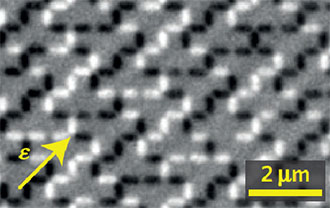
Figure 7. Photoemission electron microscopy with X-ray magnetic circular dichroism contrast (XMCD-PEEM) image of a 600 nm tetris lattice. The black/white contrast indicates whether the magnetization of an island has a component parallel or antiparallel to the polarization of the incident X-rays, which is indicated by the yellow arrow. The backbone island moments are ordered, which can be seen by noting the diagonal segments of islands with alternating black/white contrast. The staircase moments are not ordered.
Researchers explicitly designed the magnet to exhibit dimensional reduction from a two-dimensional behavior to a one-dimensional one. They experimentally investigated the lattice’s ice manifold predicted by the vertex model by fabricating material with single-domain permalloy (Ni81Fe19) islands (nominal island dimensions of 470 x 170 x 3 nm) and island spacings of 600 nm and 800 nm). As the temperature is lowered to room temperature, the magnet crosses over from being a “standard” magnet into a new and exotic state where it exhibits “dimensional reduction” with alternating ordered and disordered stripes that have distinct kinetic behaviors. The ordered stripes are static, while the disordered ones flip thermally. The stripes and their behavior can be predicted via a 1-D Ising model – the very first tool to understand phase transition, which theoretical physicists have been studying for about 80 years.
Magnetic materials that exhibit exotic/useful behaviors are found by chance in nature. Most of their interesting properties happen at low temperatures that limit technological applications. Magnets with desired properties that are functional at useful temperature ranges show potential for applications ranging from general magnetism (e.g. developing sensors) to information encoding. The research has provided a basic science advance by illustrating how emergent behaviors can be explicitly designed into a nanostructure. The insight could also lead to a material-by-design approach to magnetism that exploits the collective behavior of nano magnets for useful applications.
Reference: “Emergent Reduced Dimensionality by Vertex Frustration in Artificial Spin Ice,” Nature Physics (2015); doi: 10.1038/NPHYS3520. Authors: Ian Gilbert, Yuyang Lao, Isaac Carrasquillo, and Peter Schiffer (University of Illinois at Urbana-Champaign); Liam O’Brien (University of Minnesota, Minneapolis and University of Cambridge; Justin D.Watts, Michael Manno, and Chris Leighton (University of Minnesota, Minneapolis); Andreas Scholl (Lawrence Berkeley National Laboratory); and Cristiano Nisoli (T-4). Los Alamos researchers designed and studied the geometry of the material [Muir Morrison (former LANL student, now a graduate student at California Institute of Technology), Tammie Nelson (Feynman Fellow, Physics and Chemistry of Materials, T-1), and Cristiano Nisoli (T-4).
The work supports the Lab’s Energy Security and Global Security mission areas and the Materials for the Future science pillar through development of materials with potentially useful applications. Technical contact: Cristiano Nisoli





